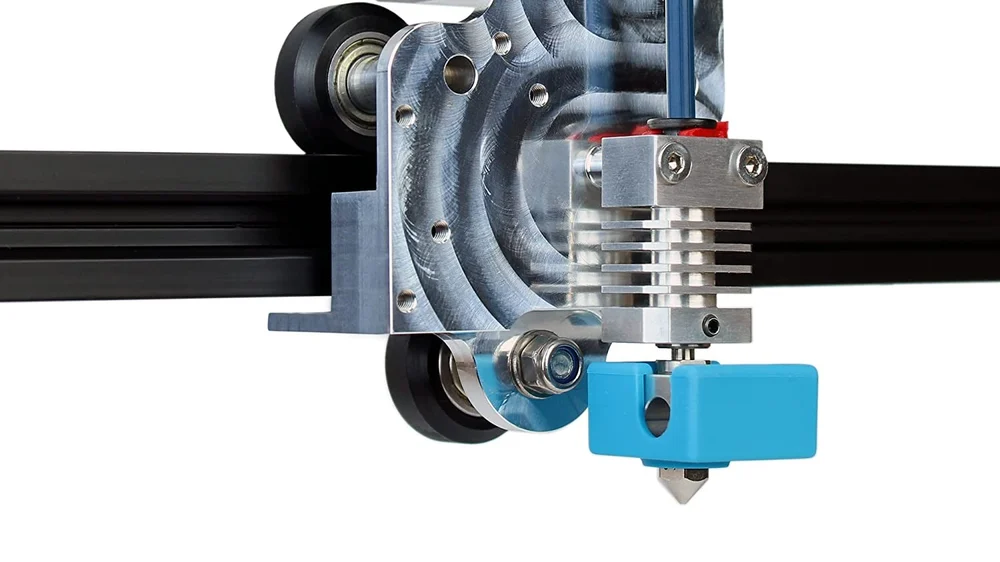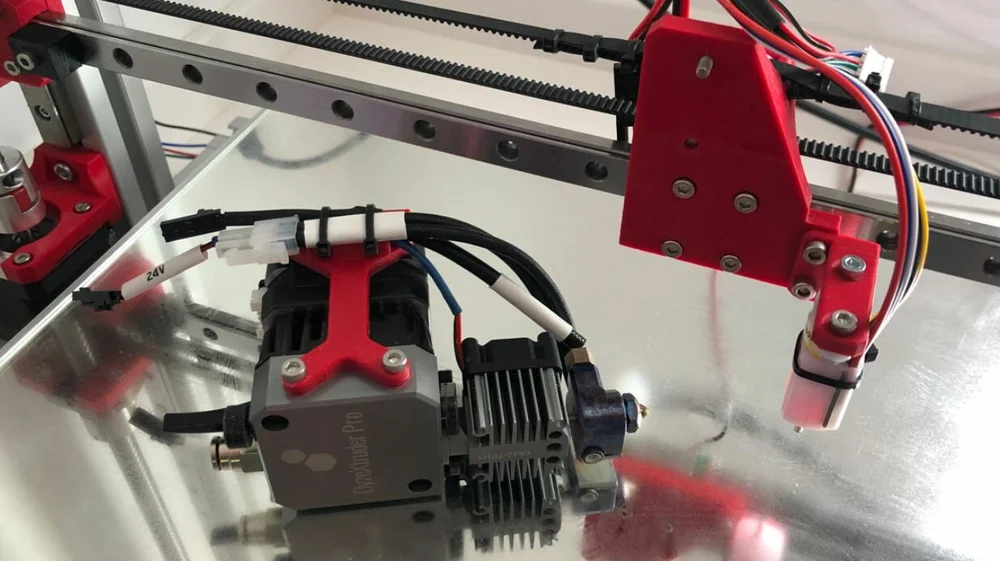There are many 3D printer hot ends out there and finding the best can be a challenge. Read on for our top picks!
The hot end is one of the most important components on a 3D printer, as it heats the filament and pushes it through the attached nozzle. Hot ends are usually a durable, conductive metal assembly, consisting of a few elements, which include a heating block, throat, PTFE liner (optional), and PTFE coupler.
The hot end is a critical component of a 3D printer, and issues in this area can have significant effects on a print. The most common issue with the hot end is a clog, which can lead to incorrect extrusion or no extrusion at all. And a common cause of hot end clogs is heat creep, where heat climbs beyond the “melt zone” of a hot end, and material melts too early, blocking the filament path.
While certain external factors can prevent heat creep, the quality of the hot end plays a big role. The better the hot end is at containing heat and establishing a constant “melt zone”, the less likely it is to clog.
In this article, we’ll look at some of the best 3D printer hot ends, discussing their features, price, compatibility, and more. Before we get into the products, though, we’ll review some aspects to keep in mind when you’re looking for hot ends.
Considerations

When shopping for a hot end, there are a few things that you should keep in mind:
- Compatible materials (maximum temperature): Different 3D printer materials require different hot end temperatures. You should think about what materials you want to print with and make sure that your hot end can reach these temperatures.
- Printer compatibility: As 3D printer hot ends aren’t universal, you’ll probably need some form of custom mount (usually 3D printed) to attach your hot end to your 3D printer. You should consider if a hot end has any mounting features that may help you. If not, make sure to check that there’s an available mount for your printer and hot end configuration.
- Nozzle compatibility: While the nozzle screws into the heater block of a hot end, it can be removed and sometimes needs to be replaced. When purchasing a hot end, make sure that the compatible screw size (e.g. M6) matches that of your preferred type of nozzle.
- Heat containment: As mentioned, heat creep is one of the most common issues for hot ends. Higher quality hot ends will contain heat better, even when printing for an extended period or with high temperatures (such as required by materials like PC). Looking at available heat demonstrations or customer reviews can help confirm this information.
- Durability: The highest quality hot ends are made out of the most durable materials. Durable hot ends last longer and are more likely to survive any accidental bumps with other parts of your printer. While it’s hard to evaluate durability for hot ends, you can check the material composition of the assembly.
Now that you know what to look for in a hot end, let’s get to the choices!
Micro Swiss All-Metal

The Micro Swiss All-Metal Hot End is an excellent choice for those looking to use materials with high printing temperatures.
At a quick glance, the heatsink may look similar to the stock hot end on Creality CR or Ender-series printers. The parallel structure makes mounting the Micro Swiss hot end onto these printers a breeze, but besides their shape, the two are very different.
As an all-metal hot end, the Micro Swiss lacks a PTFE liner, which allows it to reach high temperatures of around 280-300 °C without producing toxic fumes (from burning the PTFE tube). However, it’s worth mentioning that due to the increased temperature capabilities, all-metal hot ends are prone to clogging (e.g. heat creep clogs).
The Micro Swiss All-Metal option also features an all-metal throat (which connects the heatsink to the heating block) made of Grade 5 titanium alloy. Titanium is not only a highly durable material, it also has great heat isolation properties. According to Micro Swiss, this material offers three times lower thermal conductivity than stainless steel, the typical material choice for hot end throats.
- Filament diameter: 1.75 mm
- Supported 3D printers: Fits on most FDM printers (e.g. CR-10, Ender 3, Tevo Tornado)
- Price: ∼$65
E3D V6

With its tried-and-true reliability, the E3D V6 has proven itself capable of producing high-quality prints across a vast range of materials. With thousands of users running this hot end (or one of its many clones) on hundreds of different machines, the E3D V6 family of components will likely work on yours, too.
Yes, you’ve read that right: the E3D V6 family. A major reason for the V6’s incredible popularity is its ever-expanding ecosystem of parts. From tiny, 0.15-mm nozzles to the hefty SuperVolcano, from standard brass nozzles to the nickel-plated, WS2-coated, tool-steel Nozzle X, E3D has an unrivaled range of parts for every user and use case. There’s something for every temperature range and material.
With plenty of customization options, the V6 is sure to have your needs covered!
- Filament diameter: 1.75 mm, 3 mm
- Supported 3D printers: Fits on most FDM printers
- Price: $50-$100, depending on the model and kit
Slice Engineering Mosquito

The Slice Engineering Mosquito is a relatively new product that brings a radical, but quite successful, take on the traditional hot end design. Instead of consisting of a heatsink connected to a heater block via a thin, metal heat “break”, it builds everything off of a sturdy metal frame.
This offers a number of benefits: For thermal performance, the large, aluminum heatsink used by most other hot ends can be replaced by a more efficient copper one, as the sink no longer has to sustain any mechanical load. This means that heat creep is effectively eliminated.
Because the heater block is connected directly to the frame via four stiff rods, setup is a breeze, with no oddly-shaped mounts to worry about. One-handed nozzle changes are also possible, with no heat break to potentially damage. Speaking of nozzles, the Mosquito is compatible with E3D’s entire range of products, and Slice Engineering also produces their own Vanadium nozzles.
The Mosquito hot end proves that plug-and-play ease of use doesn’t have to come at the cost of quality. If you’re looking for a no-fuss hot end that can deliver top-of-the-line performance, and you’re willing to pay accordingly for it, the Mosquito may be right for you.
- Filament diameter: 1.75 mm
- Supported 3D printers: Fits on most FDM printers
- Price: $145-$185, depending on the model
DyzEnd Pro

The DyzEnd Pro is a small-footprint, high-temperature hot end, great for professional and consumer use, and it’s one of DyzeDesign most popular products.
Because the DyzEnd Pro is an all-metal hot end and it doesn’t use a PTFE tube liner in the heat break, it can reach up to 500 °C (if you use a 60 W heating cartridge). This high maximum nozzle temperature will allow you to print even the most advanced FDM 3D printing materials, from PLA to PMMA, even at high speeds.
Besides the temperature capabilities, the DyzEnd Pro has other great characteristics, such as a Tungsten Carbide nozzle, which the manufacturer states is very wear-resistant. The throat on this hot end is coated in ceramic material, which provides a smoother filament path through the assembly. Lastly, like many hot end products, the DyzEnd Pro also includes a fan, which fits over the small heat break to cool down the assembly and prevent heat creep.
- Filament size: 1.75 mm
- Supported 3D printers: Fits on most FDM printers
- Price: ~$130
Diabase Flexion Extruder

The Flexion Extruder is designed for doing one thing really well: printing flexibles. Flexibles are notoriously difficult to handle, but the Flexion, manufactured by the same makers of the patented NinjaFlex filament, tackles them head-on to pump out flexible plastic twice as fast as most other hot ends are capable of.
How is this accomplished? For one, the Flexion has a very restricted filament path, which prevents flexible filaments from squeezing out in an effort to take the path of least resistance. Moreover, the feeder is specifically designed with micro-teeth that better grip flexible filaments, and a replaceable wire brush is constantly clearing out the feeder teeth to ensure a consistent grip. This will land you a company-claimed 70-mm/s print speed with a 0.4-mm nozzle and 0.2-mm layer height, a respectable speed even for non-flexibles.
Diabase offers single and dual kits, a high-temperature kit, and an extruder-only, E3D-compatible assembly, covering the most extreme of flexible printing setups. If you know that you need a reliable way to tackle flexible materials, the Flexion could be the way to go.
- Filament diameter: 1.75 mm
- Supported 3D printers: Can fit on many FDM printers but fits most easily on printers with Mk8, 9, and 10 hot ends. For the most up-to-date list of supported machines, check out the official Flexion website
- Price: $150-$270
E3D Hemera

To round off our list, we have another addition from E3D, this time the E3D Hemera. Like the Titan Aero that came before it, the Hemera is designed to be an all-in-one solution for 3D printer extrusion, combining the extruder and hot end into one compact design.
At the core of the Hemera are custom-made motor faceplates that are themselves part of the extruder design, making for an extremely compact build. Not only does this compactness reduce wobble while printing, but it also enables a short filament path: The filament goes almost directly from the Hemera’s dual-drive feeder gears into the attached hot end. This works wonders for extruder precision and reliability, especially when printing flexible filaments, which can be notoriously difficult to handle.
On the outside, the Hemera sports a new heatsink, which screws directly onto the motor faceplate. This heatsink directs air away from the print bed, preventing unwanted air from interfering with your prints.
The Hemera is easily customizable to suit any budget and need. Though it was intended for direct-drive purposes, the attached hot end can be unscrewed and replaced with a Bowden fitting if desired. Mounting the Hemera is also simple, as the custom motor faceplates feature flat sides and built-in mounting holes for direct attachment to your printer.
- Filament diameter: 1.75 mm
- Supported 3D printers: Fits on most FDM printers
- Price: $120-$150